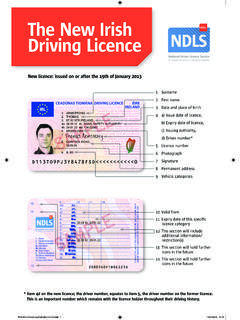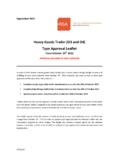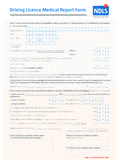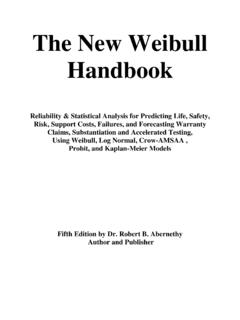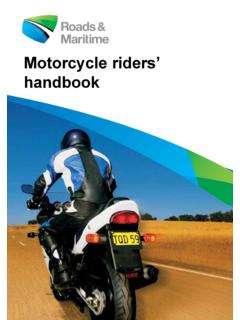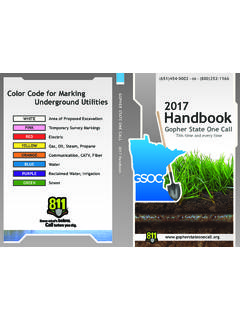Transcription of Safe Driving for Work - Drivers Handbook - RSA.ie - Home
1 safe Driving for WorkDriver s HandbookHSA Drivers Handbook 2:Layout 1 23/11/2012 12:24 Page 1 Our Vision:Influence a sustainable reductionin the numbers of people killedor seriously injured or who sufferillness as a result of Driving forwork in all economic sectors All rights reserved. No part of this publication may be reproduced, storedin a retrieval system or transmitted in any form or by an means electronic,mechanical, photocopying, recording or otherwise, without the priorpermission of the Health and Safety Authority, An Garda S och na or theRoad Safety October 2012 HSA Drivers Handbook 2:Layout 1 23/11/2012 12:24 Page 21 This Handbook has been jointly developed by An GardaS och na, the Health and Safety Authority and the RoadSafety Authority as a tool for working Drivers to help themunderstand and manage the risks that they face and createwhen Driving for work . It will help working Drivers makesafer choices about the way they drive and behave is a guidance document.
2 Using the information givenshould help you to comply with your statutory duties inrespect of safe Driving for work practices. The document isnot exhaustive and provides information, in no particularorder, on the main risks that working Drivers may encounter,as part of their work practices. All information contained in this document is accurate at thetime of publication. It is the responsibility of the reader toupdate his/herself regularly on any changes to road Traffic orSafety, Health and Welfare at work legislation that may berelevant to Driving for work . More detailed information ongeneral road safety topics can be found at Information on worker safety, health andwelfare can be found at We acknowledge input from the Royal Society for Preventionof Accidents [ROSPA UK] in partnership with DBDA UK, andthe Electricity Supply Board [ESB] for concept andreproduction of certain content. AcknowledgementHSA Drivers Handbook 2:Layout 1 23/11/2012 12:24 Page 12 ContentsIntroduction.
3 4 Summary ..7 safe Driver ..9 Driver Training ..9 Driver Qualification and Authorisation ..9 Knowledge of rules of the road ..10 Fitness to Drive ..10 Fatigue ..10 Measures to tackle driver fatigue ..11 Medical Conditions ..14 Eyesight ..15 Alcohol and Drugs ..15 Medicines and Driving ..17 Illicit drugs ..18 Daily Stress Events ..18 Personal safety ..18 safe parking ..19 Dealing with Potentially Aggressive behaviour ..20 safe Vehicle ..22 Who is responsible for the vehicle? ..22 Using your own vehicle ..22 Pre-drive vehicle checks ..23 Vehicle cleanliness ..26 Tyres ..27 Safety Equipment ..28 Seating position and safety ..28 Seat belts ..29 Child restraints ..29 Securing Loads ..31 General considerations ..31 Roof Rack/Roof Boxes ..32 Towing and Trailers ..33 Vehicle security ..35 Key security ..36 HSA Drivers Handbook 2:Layout 1 23/11/2012 12:24 Page 2 Electric Vehicles ..36 safe Journey.
4 37 Driver considerations ..37 Give yourself time ..38 Pre Journey Checks ..39 safe speed ..40 Speed limits ..41 Impact of your speed on pedestrians ..46 Distractions ..46 Mobile phones ..46In-vehicle navigation systems ..48 Other distractions ..49 safe Driving Practices ..50 Motorway Driving ..50 Joining a motorway ..51On the motorway ..51 Leaving the motorway ..53 Motorway breakdowns ..54 Driving Conditions ..55 Driving at night ..55 Weather conditions and seasonal hazards ..57Is your vehicle weather ready? ..57 Rain ..57 Driving in Snow and ice ..59 Driving in Fog ..60 Low sunshine ..62 Hot weather ..62 Dealing with Collisions and Emergencies ..63 Collisions ..63 Breakdowns ..65 Further reading ..66 Appendix 1 ..67 Appendix 2 ..68 Notes ..733 HSA Drivers Handbook 2:Layout 1 23/11/2012 12:24 Page 34 IntroductionThe purpose of this Handbook is to make working Drivers awareof some of the main risks that they may face or create whiledriving for terms of understanding how to manage the risks, thehandbook outlines what is required of a driver in terms of his orher, vehicle, journey and Driving behaviours.
5 In addition it dealswith emergency situations and gives practical advice on what todo to help keep you safe from avoidable Handbook will help you work with your employer to avoidpreventable incidents and injuries to yourself, your passengersand other people when Driving for work . It should be used withyour employer s Driving for work policies and is an essential part of work life for many people. It can beenjoyable and pleasant, but it can also be stressful anddangerous. Driving is one of the most dangerous activities thatpeople do. Every year in Ireland many people are killed andseriously injured while Driving for work . Thousands suffer seriousinjury each year. Most of these horrific incidents 1996 and 2010 over 4412 cars, 511 vans and 846 truckswere involved in fatal collisions on Ireland s roads. In addition14638 cars, 1513 vans and 1563 trucks were involved in seriousinjury collisions. It is estimated that up to 1/3 of road collisionsinvolve a vehicle used in connection with work Drivers Handbook 2:Layout 1 23/11/2012 12:24 Page 4 There are many safer choices that can be made to make sure thatyou do not become involved in an incident or road collision whendriving for Drivers have a higher collision rate than the generaldriving population, even after their higher mileages are takeninto account.
6 Drivers of company cars, vans, buses and HGV s aremore likely to take risks and to be at fault when they have adriving is not just due to Driving skills and attitudes, but may also bedue to the nature of the Driving that at- work Drivers do, thevehicles they drive and the amount of time spent behind thewheel or on the road . The greater the time spent behind thewheel, the greater the exposure to risks associated with drivingfor work . If you drive more than 40,000 kilometres per year, youare considered to be at high risk of having a Drivers Handbook 2:Layout 1 23/11/2012 12:24 Page 56 Young at- work Drivers in particular may find themselves drivingvehicles (such as vans) in which they did not learn to drive andhave little or no experience of joint HSA and RSA Employer Guidance on Driving for Workreminds employers that health and safety law applies to drivingfor work in the same way as for all work activities.
7 Driving risksshould be effectively managed within the safety managementsystem that employers should have in place for managing allwork related law, your employer needs to make sure, that when you aredriving for work , you are: Legally entitled to drive the vehicle you are using Using a vehicle that is safe and roadworthy Properly informed, trained, competent and fit to drive it safely Using the vehicle safely [as per manufacturer s and employer instructions]IntroductionHSA Drivers Handbook 2:Layout 1 23/11/2012 12:24 Page 6 SummaryFor ease of reference the Handbook is divided into four clearlymarked sections and each section is briefly outlined below; safe DriverDrivers must hold a valid Driving licence for the vehicle beingdriven and carry it while Driving . It is vitally important tounderstand and obey all the rules of the road and to updateyourself regularly on road safety. Drivers have an individualresponsibility for their Driving behaviour.
8 Drivers must assesstheir fitness to drive. Never drink and drive. Never drive underthe influence of drugs [prescribed or over-the counter]. Neverdrive when tired. Drivers must wear a seat belt on JourneyBefore setting off, always plan your route and check forweather and traffic updates. Always drive at the appropriatespeed for the prevailing conditions. Always use daytimerunning lights and slow down or even cancel your journey insevere weather conditions [rain, fog, high winds, ice or snow] safe VehicleAlways carry out a vehicle pre-check before using your should be done daily and a more detailed check should becarried out weekly or as prescribed by your employer. Makesure loads are securely stowed or fastened in the vehicle. Ifcarrying loads on the vehicle, loads must be appropriatelystowed and restrained to prevent any movement Drivers Handbook 2:Layout 1 23/11/2012 12:24 Page 78 Dealing with Collisions and EmergenciesPersonal safety and the safety of any passengers should alwaysbe your first consideration.
9 Use your hazard warning lights and hi-visibility clothing to make sure you and your vehicle can beseen by other road users. Collisions that result in injury whiledriving for work should be reported to the Gardai, asappropriate [refer to Appendix 1], and your line managerimmediately. Details should be recorded on a preliminaryincident report Drivers Handbook 2:Layout 1 23/11/2012 12:24 Page 8 safe Driver As a driver, you must play your part by making sure that youare fit to carry out your Driving duties. You should plan yourjourneys safely and obey occupational health and safety, androad traffic laws when Driving for work . You also need tounderstand and follow your employer s Driving for workpolicies, procedures and TrainingDrivers should consider maintaining their skill and knowledgeby undergoing regular refresher training. Your employer mayhave specific vehicle familiarisation or refresher trainingprocedures in place.
10 When required to drive a vehicle withwhich you are not familiar take time to inform yourself on thesafe operation of that vehicle type before going on Qualification and AuthorisationAs part of Driving for work policy and procedures, you should beauthorised to drive for work by your employer and you shouldsubmit the following documentation to your employer to verifythat you are suitably qualified and authorised to drive:- Valid Driving licence for the category of vehicle Driving licence endorsements or penalties Proof of insurance and type of use Details of any medical conditions related to drivingALL Drivers MUST CARRY A VALID NATIONAL ORINTERNATIONAL Driving LICENCE FAILURE TO DO SO IS AN OFFENCE9 HSA Drivers Handbook 2:Layout 1 23/11/2012 12:24 Page 910 Knowledge of rules of the roadYou must have a satisfactory knowledge of the rules of the roadto get a Driving licence, but learning about road safety does notstop once you pass your test.






